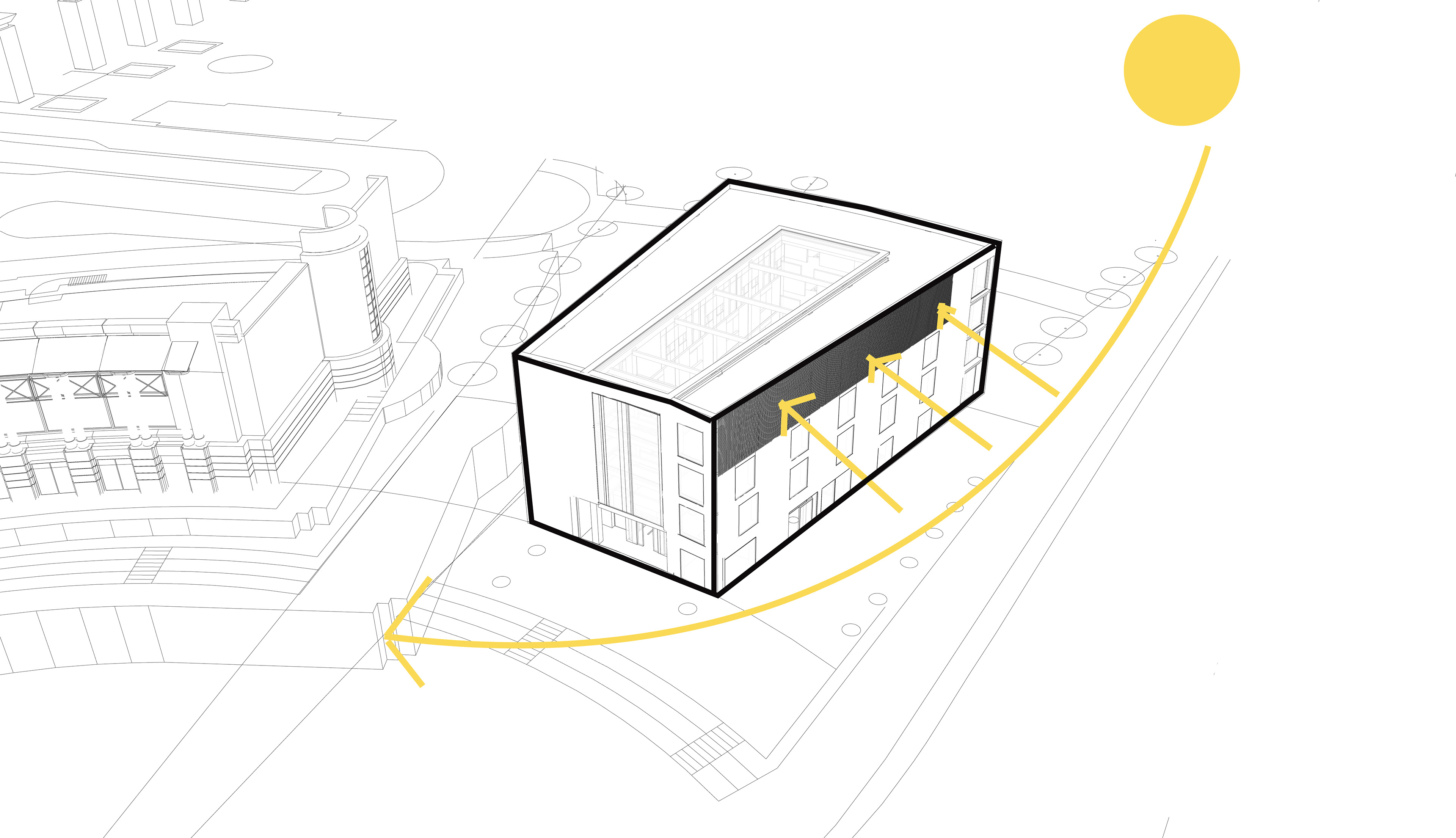Project Design and Environmental Design
I view the library as the treasure chest of the city. The design concept is one that encases, protects and treasures both the books and people that it holds. Therefore, I based the structure of the building around rows of individual study pods. These seat occupants almost within the wall, with windows that look down onto the atrium. These separate windows appear as precious speckles of light shining down onto the main civic ground floor and display separate people in their own intimate space.
Site Response: Lloyd's Ampitheatre. I subtended the Lloyd's Building's strong arc shape and placed the walls of the library on the radius from its centre point. This gave the library a soft approach to responding to its environment . I designed the landscaping to create easy access points and cause visitors to feel as if they're being pulled towards and into the secretive, library.
Plan of Orientation and Landscaping
Early Sketches of Storage Ideas. The final structure of the library was formed around this caring, protective "U" formed shape.
1:20 Balso Model of Bench Seat-cum-Book Shelf.
Inspired by form of free-flipping pages.
North External Perspective - Collage

Shading Strategy
Whilst the glazing has the highest U-value, this is counteracted by its lower total area. The building has a moderate glazing to wall ratio (28.740%) as the deeply embedded reading spaces having external views was considered alongside the need to avoid excessive heat loss through glazing.
Therefore, there is minimal need for shading devices. The main focus area is on the top floor's western façade, as the reference library books facing the window may otherwise be subjected to UV degradation during the morning and early afternoon (refer to sunpath diagram). In response to this need and the building's solid treasure chest aesthetic, the proposal's shading strategy is to use the articulated cladding system of stereokinetic mesh panels. As the panels are individually hung from mesh, their placement may be optimised to reduce unnecessary use of material.
Therefore, there is minimal need for shading devices. The main focus area is on the top floor's western façade, as the reference library books facing the window may otherwise be subjected to UV degradation during the morning and early afternoon (refer to sunpath diagram). In response to this need and the building's solid treasure chest aesthetic, the proposal's shading strategy is to use the articulated cladding system of stereokinetic mesh panels. As the panels are individually hung from mesh, their placement may be optimised to reduce unnecessary use of material.
Passive Solar Design
Collection
The building uses a direct gain system as sunlight enters predominantly through the south façade's glazing and rooflight. An average solar gain of 25W/m2 on a July day means an efficient solar gain strategy must be utilised.
Storage:
The ground's large concrete slab passively acts as a thermal mass and moderates diurnal temperature swings. This reduces heating requirements during evening use.
Distribution:
Distribution:
The design proposal has optimum opportunity for stack ventilation due to the internal windows creating open passages to the tall central atrium. The open user circulation around the perimeter of the building further allows for cross ventilation.
Conservation:
Double glazing with a low-emissivity coating is used, therefore, heat is stored within the sealed unit.
The entire outer circulation acts as zoning/a buffer space thermally, providing low heat loss for this space.
During the winter, the concrete thermal mass holds the absorbed heat for longer and reduces boiler demand.
Natural Ventilation
Excluding the South façade's ceiling height glazing and in the toilets (which are vented), all the windows in the building are user-operable. Therefore the scheme allows for natural ventilation enabled by the SW prevailing wind entering the building and keeping the internal air cool and of good quality. Cross-ventilation shall occur on each floor, with buoyancy-driven ventilation in the atrium being assisted by an extractor fan on the roof and the rooflight's remotely operable celestory windows (at a 1.8m pop-up height).
The atrium's narrow width of 8m and maximum height between floors of 3.5m follow CIBSE recommendations for appropriate and efficient natural ventilation and enables air to be stratified.
Ground Floor
First Floor